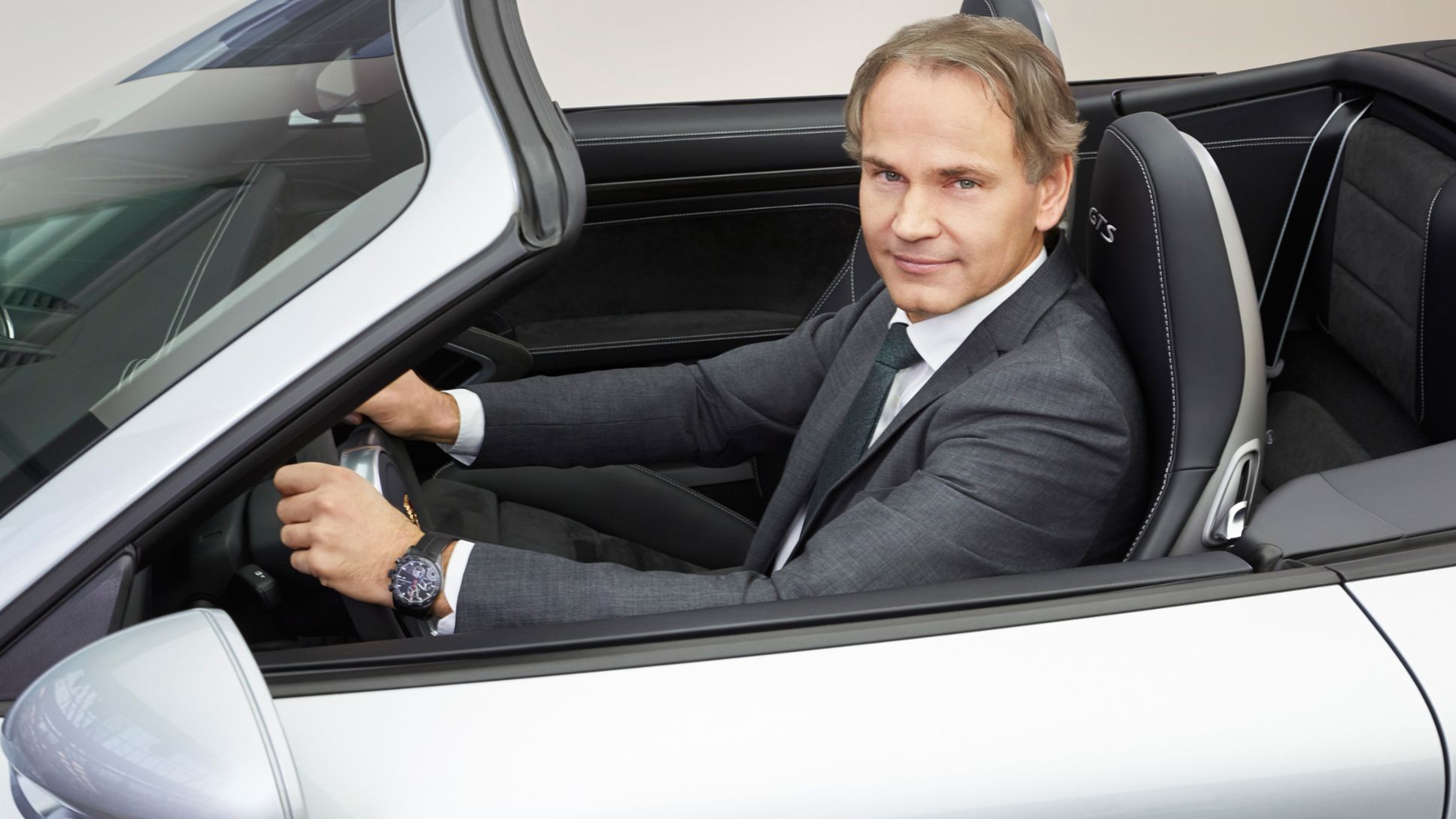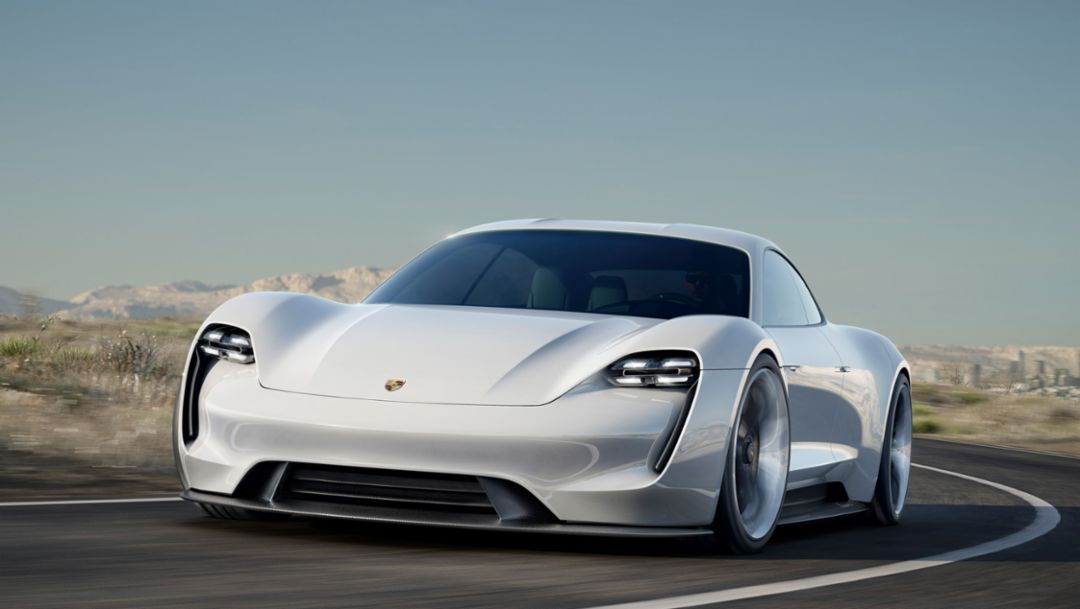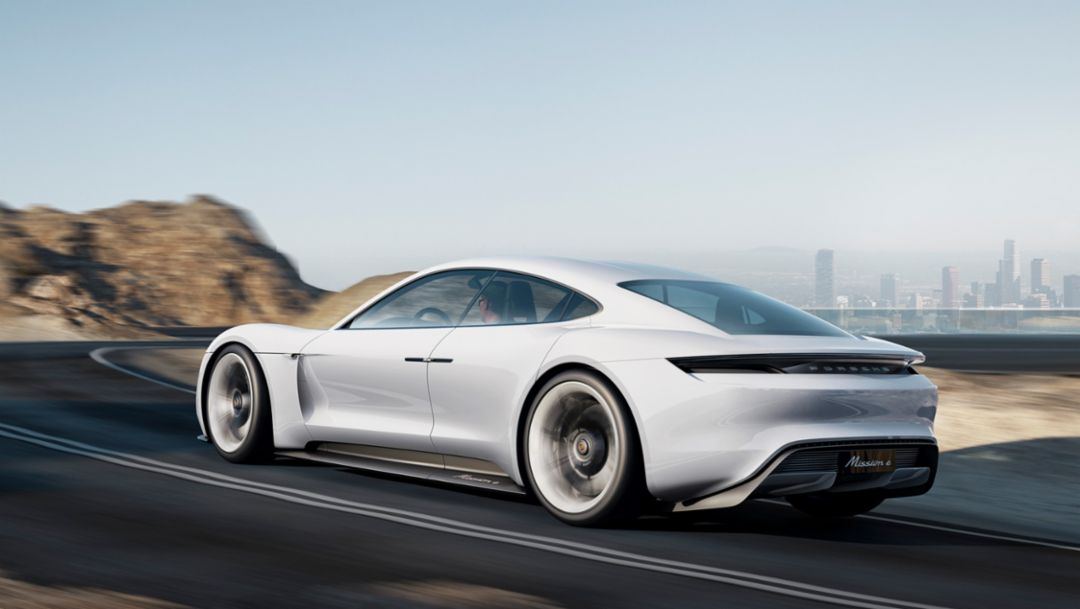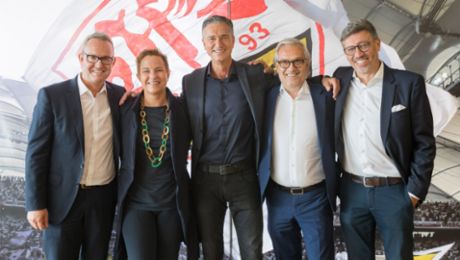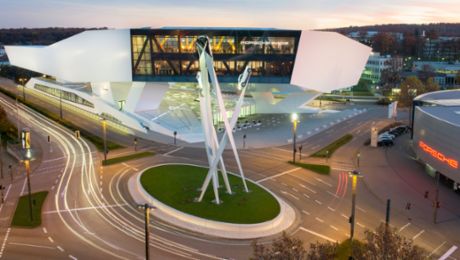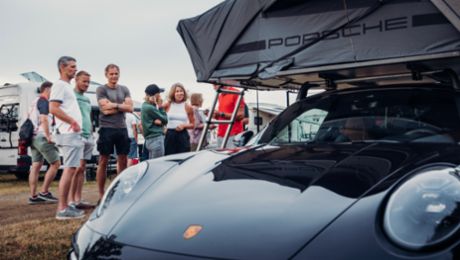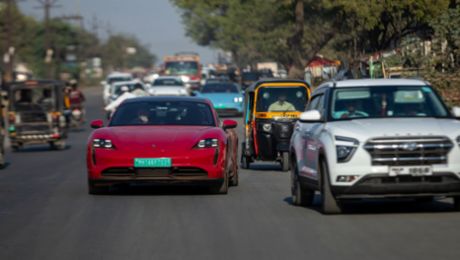Mr Blume, the Mission E is Porsche’s first purely battery-driven car – a concession to the market or a departure into a new world of Porsche?
No, not a concession, more of an enrichment. And yes: we are setting a bold exclamation mark for the future of the brand.
The automotive industry is offering an increasing number of electric vehicles, while at the same time it is developing from a pure maker of cars to a supplier of mobility. Is this transformation also a must for Porsche?
Yes, of course it is. For us, too, there is no avoiding the fact that customer expectations of our vehicles are changing. Electrification, digitisation, connectivity – these are the big three in car building in the new century. In the future, it will depend massively on how we transfer the buying and usage behaviour of our customers to new vehicle generations and nonetheless remain faithful to our principles. What we offer will in part be different. But whatever is labelled Porsche must always be Porsche inside. I call it emotional sportiness.
How much Porsche is there in the Mission E?
The technology of the car is radically new. Yet the philosophy behind it is pure Porsche: our objective has always been to offer the sportiest and technologically most sophisticated vehicle in each of our market segments. That is true of the 911 and 718, the pure sports cars, it is also true of the Cayenne, Macan and Panamera – and it will be true of the Mission E.
From the onset, the stance of Tesla has been that electric mobility does not have to be a form of renunciation but should fulfil the expectations of a modern premium-class saloon without any sacrifices. This has earned it a lot of applause.
Tesla has introduced many new facets. It has provided the industry with genuine stimuli. And that deserves respect. Nevertheless, it is not yet economically successful. Our response is to link traditional sports car genes from our decades of experience with fresh ideas and bold ways of thinking. Yet that is by no means everything. Investment in a new model series at Porsche always has to be a promise of returns as well. Otherwise we prefer to let it be.
On the subject of investment: Porsche is investing a lot of money in its headquarters in Zuffenhausen. How much exactly, and for what?
We are investing a good billion euros in the Mission E alone. The lion’s share of this, roughly 700 million euros, in Zuffenhausen. That shows how seriously we are taking the matter. We are not just experimenting around to see what comes out of it. We are investing heavily in our future because we are convinced of doing the right thing at the right time. The next few years will see a new paint shop and a separate assembly plant in Zuffenhausen. The existing engine plant will be expanded for the production of electric drives. In addition, we will be extending the existing body shop. All together, more than 1000 jobs will be created there. That is more than just words.
For the Works Council, “Porsche is driving at full throttle without any speed limit into the automotive and industrial future”.
Nicely put.
Why Zuffenhausen?
This is where the heart of Porsche beats. Everything has developed from here; this is where the future has a tradition. Zuffenhausen is the home of the 911, the icon of the brand. What could be a better site for a car that marks the beginning of a new Porsche era?
You not only associate the Mission E with an upgrading of Zuffenhausen as a production site but also of Baden-Württemberg as a technology location and the entire German automobile industry. How important is that?
Very important. What the German automotive industry does, particularly in the premium class, has great weight internationally. Other industries have lost this status, some no longer exist. This edge has to be defended, if possible, and even extended, which is not exactly easy. With Mission E, things will start to move. The concept transports electric mobility into a new dimension. It is a signal, a message that says: Look here. This is where we call the tune, here in this country. Period.
The oil price is falling and this is making it more difficult for people to enter the expensive world of electric mobility. Have we finally miscalculated with extremely ambitious forecasts?
The fact is we don’t want to and can’t reverse the developments – we have no choice. And you don’t have to be a clairvoyant to predict that the oil price will go up again. The current trend is deceptive. However, the fact is that, without a helping hand, we will not achieve the ideal vision we have in mind: the leap into a new era.
Are you thinking of tax incentives?
No, not necessarily. A sound charging infrastructure is much more important. If we want to achieve the breakthrough for electric cars, it will not be possible without it. It would be nice if industry and politicians worked towards a common aim in order to tackle the challenges. However, that does not mean that we can take it easy. Our innovations are the crucial factor. They are what it all depends on. Market leadership does not come from subsidies but from superior technology. Once we have it, everything comes automatically.
Porsche doesn’t exactly contribute to mass transportation.
And our cars are not there for that purpose, either. But it is our ideas that will make electric mobility suitable for the masses.
For a long time now, innovations in matters of mobility have not just been coming from the automobile industry. How seriously do you take the new competitors such as Apple, Google and Microsoft?
Can Apple build a comparable Porsche? No. Does Apple want to build a Porsche? No. Does Porsche then need to worry about Apple as a competitor? No, no and three times no. Does that mean we can ignore Apple and their ilk? Certainly not! I’m impressed by the tremendous technological dynamism of this company. We can only learn from this and we will have to see how things stand with our skills in dealing with these players. Either we have the skills or we will have to develop them.
Developing may mean a partnership with a major IT service provider. Is that a good idea?
We self-confidently concentrate on what we can do: develop and build fascinating sports cars. We link this with tomorrow’s technology in smart and intelligent ways. Partnerships are not a bad idea in principle if you discover that your own skills are not sufficient and there is no way of regaining the competitive edge without difficulty. However, for Porsche I see things a little differently. There are two reasons for this. Firstly, compared with other companies, we are a niche supplier and part of a large corporation. And secondly, we do not aspire to marching ahead in this field. We will leave that to others. We prefer to concentrate on what we can do best and what our customers expect from us: the development, construction and sale of highly emotive premium sports cars.
Nevertheless, to what extent will and must Porsche change under the pressure of IT? In ten years’ time, software, IT and electronics will account for 30 per cent of the value-added share in a car. Today they make up three to five per cent.
Well, you know Porsche will always have a special role. Of course, we can’t and don’t wish to turn a deaf ear to the wishes and requirements of our customers. It would be particularly negligent if we failed to acknowledge the great changes in the world of mobility and did not draw our conclusions from this. Connectivity, for example, is a major topic. The main concern here is the right combination of usability and new technology. Our cars should be able to connect meaningfully with the environment.
Will the Mission E be a self-driving car?
You may assume this vehicle will offer everything you can expect from a genuine Porsche, above all an unrivalled driving experience, including the fun of driving.
What is your view of a self-driving Porsche?
A Porsche is something that you want to drive yourself. There are, however, interesting subfunctions.
Who is the hunter with respect to the Mission E and who is the hunted?
We concentrate on ourselves. And set standards. The market regulates everything else. We have only ourselves to beat.
What makes you so sure?
The technology of the car. It combines excellent driving performance and forward-thinking practicality with the unmistakeable Porsche design. In plain language this means the first 800-volt drive system, hence a doubling of voltage compared with current electric vehicles. The Mission E produces a system output of 600 hp, a range of more than 500 kilometres. It has all-wheel drive, accelerates from zero to 100 km/h in less than 3.5 seconds. Eighty per cent of the electrical energy can be reloaded in roughly 15 minutes’ charging time. In this car you can drive to the bakery. But also on a closed race track. Or on the boulevard. You will always somehow feel at home.
The Mission E represents new territory for Porsche. How great is the risk?
Yes, it is a new car. But no, it is not as though we were having to start from scratch with electric mobility, not by a long shot. Instead, we are drawing upon our existing strengths. Firstly, Porsche invented the hybrid drive. That was a long time ago, which is why it is easily forgotten. Secondly, we were the first premium manufacturer to offer hybrid drives in three different vehicle classes. Who would have expected that of us? However, thirdly, all this is nothing compared to what we have achieved with electric mobility in motor racing. After a perfect motorsport season, we even became world champion in November.
In 2015, Porsche recorded a double victory at Le Mans. In the FIA World Endurance Championship (WEC), you won both the manufacturer’s and the driver’s classification for the first time. What was the decisive factor?
The way we did it! Within the framework of an extremely demanding set of regulations, we lined up at the start with the most technically complex car. We confidently mastered the championships with this car and did so in only our second year of competition. We put on a unique display of team performance. But it’s not possible with power alone. It calls for perfect interplay between drive, aerodynamics and lightweight construction. No other race car transfers so much energy as the 919 Hybrid, no other car handles it so efficiently – neither in Formula 1 nor on the endurance track. Just take our exhaust energy recuperation – a fundamentally new system that no other manufacturer uses. The 919 Hybrid produces more than 1000 hp and was the only vehicle to enter in the maximum energy class of the WEC race series: in what is known as the eight-megajoule class. This means that the car was allowed to use a maximum of 4.76 litres of petrol on the 13.629 km lap at Le Mans. This is only possible with exceptionally efficient energy storage, i.e. the lithium iron phosphate battery that has been developed specially by us.
What are the benefits for everyday use?
The 919 Hybrid is the sum total of 60 years of Porsche motorsport. The car is our technology platform for testing innovations, which are then applied in series production. This applies to both combustion engines and hybrid systems. In the petrol engine, for example, the exhaust energy can be used for increasing efficiency along with supercharging and downsizing. In the hybrid system, it is the handling of higher voltages and power densities as well as the new electric motor we have developed ourselves. There are other examples, though.
Such as?
Le Mans is an extreme stress test for the durability of batteries. They undergo more charging cycles there than during the entire lifetime of a plug-in hybrid. More driving takes place in the 24 Hours of Le Mans than in an entire Formula 1 season. Another example is lightweight construction. The underbody battery located in the floor of the car is based on the latest lithium-ion technology and, in the Mission E, extends over the full length of the vehicle between front and rear axles. Consequently, the weight is distributed evenly over both drive axles and ensures a harmonious balance. What’s more, as a result, the sports car’s centre of gravity is extremely low. Both of these factors increase performance and the sports car feeling significantly.
To be specific: What do the 919 Le Mans winner and the Mission E have in common?
Similar to Le Mans, two permanent-magnet synchronous motors accelerate the Mission E – and they recuperate energy when braking. They supply their full power even when accelerating frequently at short intervals. This is still unknown territory today. The demand-controlled all-wheel drive with Porsche Torque Vectoring – in other words, the automatic distribution of the torque to the individual wheels – transfers the power to the road. All-wheel steering defines the desired direction with sporting precision. As a result, the Mission E stays below the eight-minute mark on the North Loop of the Nürburgring. In other words, it is damned fast.
What will motivate a Porsche customer to switch from a classical Turbo to a purely battery-driven Porsche?
The fascination of Porsche. Nothing else. Driving a car with the Porsche crest will always be something special. Regardless of which engine it has. After all, one thing is certain: we will not be making any compromises.
The Mission E is the first purely battery-driven Porsche. Will there be others from your company?
We are concentrating on our first – and on the hybridisation of our fleet.
In the 911 as well?
In the 911 as well.
And what about further purely battery-driven Porsche cars?
We are thinking about that. But one thing at a time.
The new mobility also includes new mobility concepts. Are you involved in this as well?
Yes, we are. In fact, we have even established a separate division that deals with smart mobility.
With what exactly?
We have to deal with the issue of what it means for Porsche and our customers. We need an architecture that perfectly integrates external devices and is capable of being updated without difficulty. The Mission E concept car, for example, can be configured externally from a tablet via Porsche Car Connect. Using “Over the Air and Remote Services”, the driver can essentially change the functional content of the vehicle overnight. A simple update via the integrated high-speed data module is all it takes to implement the travel guide or additional functions for the chassis, engine or infotainment system. The driver can use a smartphone or tablet to start updates conveniently from the Porsche Connect Store. Furthermore, Porsche Connect enables direct contact to a Porsche Centre for remote diagnostics or to schedule appointments.
When will the Mission E be coming onto the market?
It will be ready at the end of the decade.
And how many of them are you going to build?
In any case, there will be enough.
